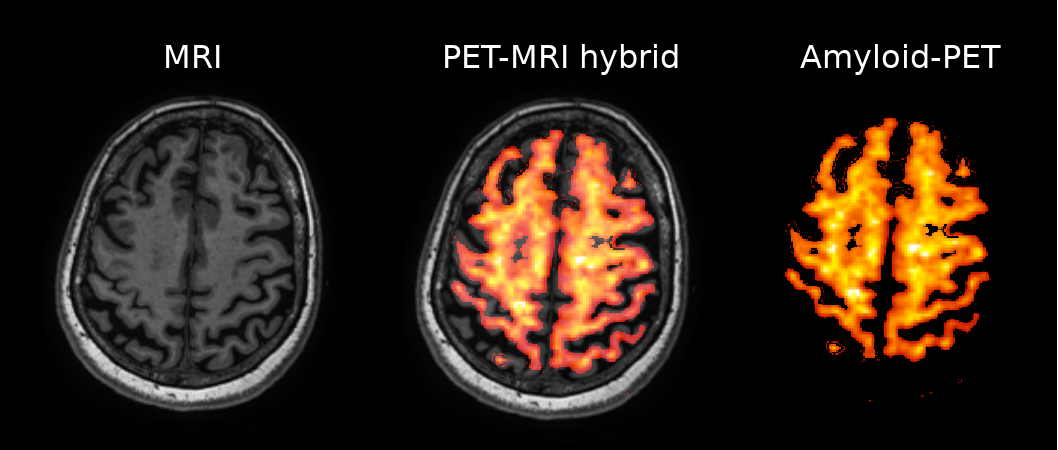Our Research
Our Research
The Newcastle PET Centre has been set-up to provide non-invasive imaging facilities for the University and its partners.
The Newcastle PET-MRI Centre has been set-up to provide non-invasive in vivo imaging of organ function and structure for the University and its partners. The hybrid GE Signa PET - 3 tesla MRI scanner provides state of the art imaging and allows simultaneous acquisition of 3D PET and MRI data. There are additional features available for radiotherapy planning: injection of MR contrast agents, MR elastography, respiratory and cardiac gating, functional BOLD fMRI, and multishell diffusion tensor imaging.
Our programme is research based though clinical scans can be available on request from local NHS trusts. Our PET programme primarily relies on 18F-fluorotracers produced by our PET tracer production unit (PTPU) or purchased externally. The PET-MRI was part funded by the Medical Research Council as part of Dementia Platform UK which comprised a network of PET Centres including Edinburgh, Cambridge, UCL, ICL, KCL, Manchester, and Sheffield. We recently completed an MRC funded harmonisation study in order to show that subjects scanned twice across different centres showed similar PET amyloid tracer uptake findings.
Our current strategy is to develop PET tracers on site which can serve multiple research programmes. Examples of radiotracers in the pipeline include:
18F-DPA714 – a marker of activated monocytes, macrophages, and brain microglia. DPA714 PET can detect the extent, sites, and quantity of brain inflammation in dementias and other neurodegenerations including Parkinson’s and motor neurone diseases, after trauma or stroke, and in people with multiple sclerosis (MS) and other neuroinflammatory disorders. In MS PET can detect inflammation in appparently normal grey and white matter on MRI and is predictive of eventual outcome. It can also be used to determine whether anti-inflammatory strategies are effective in dementia, post-stroke and trauma cognitive impairment, MS, and, if present, post-COVID syndromes.
It has been reported that both depression and schizophrenia can be associated with increased microglial activation. We will use DPA714 PET to determine whether microglial activation is present in bipolar disorder.
In systemic disorders DPA714 PET can detect lung inflammation in asthma and post COVID, discriminate bowel inflammation from irritable bowel syndrome, and measure severity of joint inflammation.
18F-FEOBV – a marker of acetylcholine vesicle transporter. FEOBV PET can measure loss of brain cholinergic projections in Alzheimer’s disease, dementia with Lewy bodies, and Parkinson’s disease. Loss of cortical cholinergic function correlates with impared memory and attention and is associated with depressive features while loss of thalamic cholinergic function is found in PD subjects with gait disorders.
FEOBV PET may also have utility for detecting certain cancers as prostate and bowel cancers are rich in cholineric innervation. Another tracer that is ideal for detection of gliomas is the aminoacid 18F-fluoroethyltyrosine (FET) as, unlike FDG, it has a low brain background signal. We are linking with a German consortium that is currently evaluating the utility of FET PET.
We are able to purchase 18F-FDG and 18F-florbetaben. FDG PET can be used for studies of organ metabolic function and detection of cancers and their metastases and to measure the efficacy of radiotherapy and cytotoxic drugs. Florbetaben PET detects the extent and load of β-amyloid deposits in possible cases of Alzheimer’s disease and can determine whether experimental anti-amyloid immunotherapies can clear these deposits.
Hybrid PET-MRI has the potential to measure brain structural and functional connectivity with diffusion tensor and BOLD imaging while simultaneously examining changes in neurotransmitter levels with PET. We are currently reviewing which 18F-fluorotracers that bind to brain receptors are sensitive to synaptic transmitter level changes when they are altered either by behavioural paradigms or after drug interventions. An example is 18F-fallypride PET which has been reported to detect changes in both striatal and cortical dopamine release.

